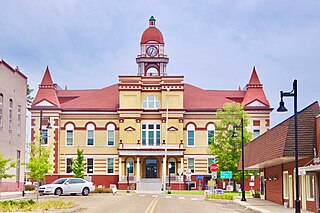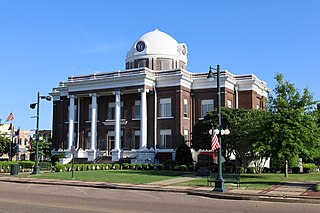
Weakley County is a county located in the northwest of the U.S. state of Tennessee. As of the 2020 census, the population was 32,902. Its county seat is Dresden. Its largest city is Martin, the home of the University of Tennessee at Martin. The county was established by the Tennessee General Assembly on October 21, 1823, and is named for U.S. Congressman Robert Weakley (1764–1845). Weakley County comprises the Martin, TN Micropolitan Statistical Area.

Obion County is a county located in the northwest corner of the U.S. state of Tennessee. As of the 2020 census, the population was 30,787. The county seat is Union City. The county was formed in 1823 and organized in 1824. It was named after the Obion River.

Gibson County is a county located in the U.S. state of Tennessee. As of the 2020 census, the population was 50,429. Its county seat is Trenton. The county was formed in 1823 and named for John H. Gibson, a soldier of the Natchez Expedition and the Creek War.

Dyer County is a county located in the westernmost part of the U.S. state of Tennessee. As of the 2020 census, the population was 36,801. The county seat is Dyersburg. Dyer County comprises the Dyersburg, TN Micropolitan Statistical Area.

Dyersburg is a city and the county seat of Dyer County, Tennessee, United States. It is located in northwest Tennessee, 79 miles (127 km) northeast of Memphis on the Forked Deer River. The population was 16,164 at the 2020 census, down 5.72% from the 2010 census.

Trenton is the county seat and fourth largest city of Gibson County, Tennessee, United States. As of the 2020 census, the population was 4,240.

West Tennessee is one of the three Grand Divisions of Tennessee that roughly comprises the western quarter of the state. The region includes 21 counties between the Tennessee and Mississippi rivers, delineated by state law. Its geography consists primarily of flat lands with rich soil and vast floodplain areas of the Mississippi River. Of the three regions, West Tennessee is the most sharply defined geographically, and is the lowest-lying. It is both the least populous and smallest, in land area, of the three Grand Divisions. Its largest city is Memphis, the state's second most populous city.
Southwest Tennessee Community College is a public community college in Memphis, Tennessee. As the product of a merger between two colleges in 2000, the school has two campuses in Memphis and several satellite centers. It is operated by the Tennessee Board of Regents.

The Obion River system is the primary surface water drainage system of northwestern Tennessee, United States.
The 8th congressional district of Tennessee is a congressional district in West Tennessee. It has been represented by Republican David Kustoff since January 2017. The district appears rural on a map, but the bulk of its vote is cast in the suburban and exurban areas around Memphis, such as Germantown, Bartlett, and Collierville, as well as Fayette and Tipton counties. This area boasts some of the highest median incomes in the state.
A flash flood watch is severe weather watch product of the National Weather Service that is issued when conditions are favorable for flash flooding in flood-prone areas, usually when grounds are already saturated from recent rains, or when upcoming rains will have the potential to cause a flash flood. These watches are also occasionally issued when a dam may break in the near future.

The 2000 United States presidential election in Tennessee took place on November 7, 2000, and was part of the 2000 United States presidential election. Voters chose 11 representatives, or electors to the Electoral College, who voted for president and vice president.
An excessive heat watch is a notice issued by the National Weather Service of the United States when the heat index is expected to be greater than 105 °F (41 °C) across the northern states or 110 °F (43 °C) across the southern states during the day, and/or nighttime low temperature will be at least 75 °F (24 °C) or higher for two consecutive days. Note that even with the usual northern/southern criteria, local offices, particularly those with deserts or mountainous terrain, often have their own criteria. High values of the heat index are caused by temperatures being significantly above normal and high humidities, and such high levels can pose a threat to human life through conditions such as heat stroke.

State Route 54 is a west–east rural highway in West Tennessee, which runs from Covington to just north of Paris.

The 1992 United States presidential election in Tennessee took place on November 3, 1992, as part of the 1992 United States presidential election. Voters chose 11 representatives, or electors to the Electoral College, who voted for president and vice president.

State Route 190 is a 55.3-mile-long (89.0 km) north–south state highway that traverses the farmland of West Tennessee. It connects Trezevant and South Fulton via Pillowville, Gleason, Palmersville, and Latham.

Tennessee's 24th Senate district is one of 33 districts in the Tennessee Senate. It has been represented by Republican John Stevens since 2012, succeeding Democrat Roy Herron.












